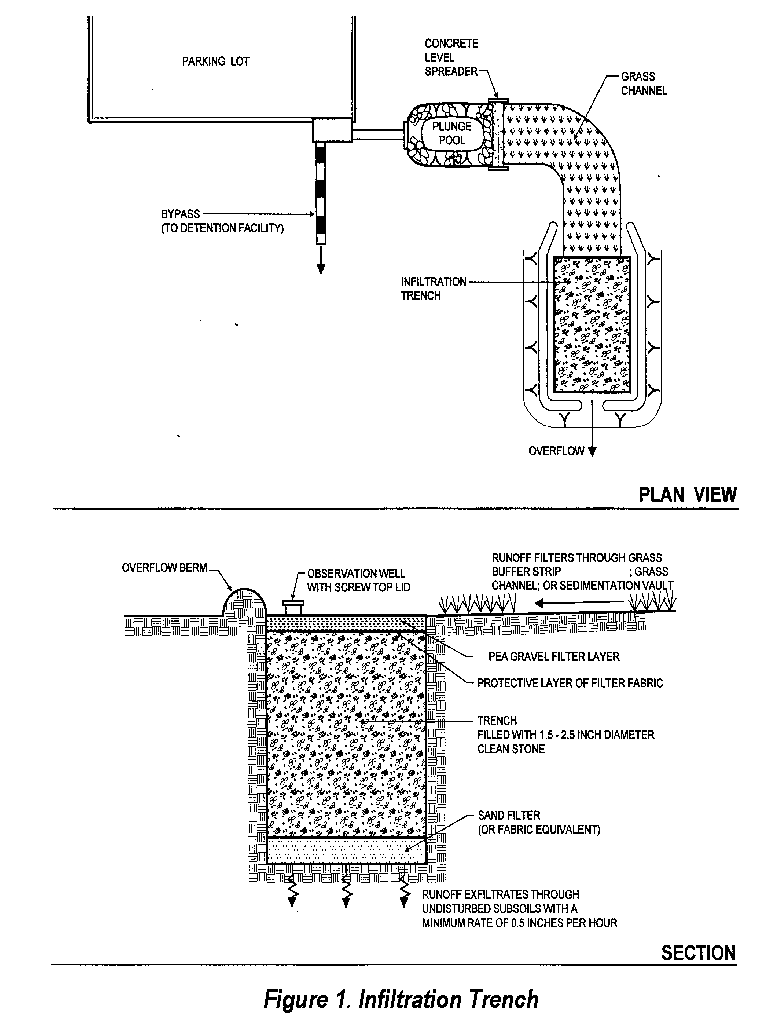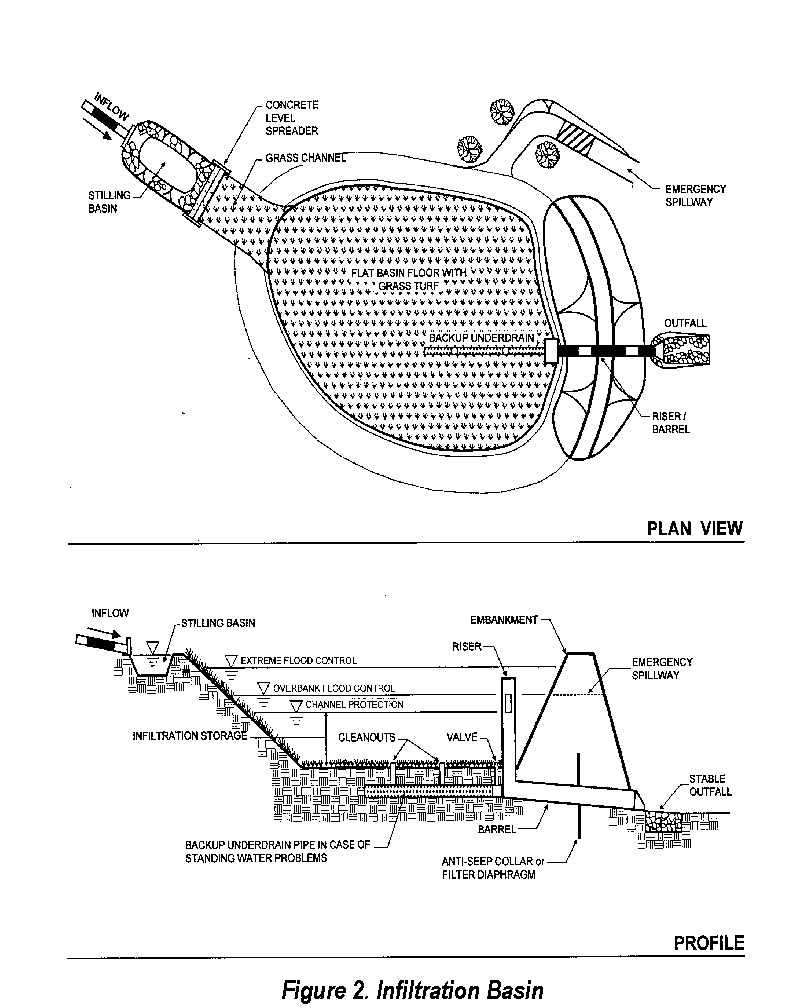Performance Criteria: Stormwater Infiltration
Stormwater infiltration practices capture and temporarily store the WQv before allowing it to infiltrate into the soil over a two day period. Design variants include:
This section presents criteria for:
A summary of the design criteria is provided in Table 1. The table separates required or minimum design elements from design criteria that would act primarily as guidance.
Infiltration practices are an excellent technique for meeting the recharge requirement (Rev), and may also provide stormwater detention (Qp) and channel protection (Cpv) storage in certain limited cases. Extraordinary care can be taken to assure that long-term infiltration rates are achieved through the use of performance bonds, post construction inspection and long-term maintenance.
| Table 1. Design Criteria: Infiltration | |
| Required Elements | Guidance |
| Feasibility | |
|
|
| Conveyance | |
|
|
| Pretreatment | |
|
|
| Treatment | |
|
|
| Landscaping | |
|
|
| Maintenance | |
|
|
![]() Please
note that judgement is needed to separate minimum design elements from guidance.
When crafting a local or state design manual, the jurisdiction will need to
go through a process involving stakeholders to select which design elements
are necessary in all cases.
Please
note that judgement is needed to separate minimum design elements from guidance.
When crafting a local or state design manual, the jurisdiction will need to
go through a process involving stakeholders to select which design elements
are necessary in all cases.


Infiltration Feasibility Criteria
To be suitable for infiltration, underlying soils can have an infiltration rate (fc) of 0.52 inches per hour or greater, as initially determined from NRCS soil textural classification, and subsequently confirmed by field geotechnical tests. The minimum geotechnical testing is one test hole per 5000 sf, with a minimum of two borings per facility (taken within the proposed limits of the facility).
Soils shall also have a clay content of less than 20% and a silt/clay content of less than 40%.
Infiltration cannot be located on slopes greater than 6% or within fill soils.
To protect groundwater from possible contamination, runoff from designated hotspot land uses or activities cannot be infiltrated.
The bottom of the infiltration facility shall be separated by at least four feet vertically from the seasonally high water table or bedrock layer, as documented by on-site soil testing.
Infiltration facilities can be located at least 100 feet horizontally from any water supply well.
![]() Additional
restrictions may be put in place to reduce the risk of contamination of a sole
source aquifer or region with karst topography.
Additional
restrictions may be put in place to reduce the risk of contamination of a sole
source aquifer or region with karst topography.
Infiltration practices can not be placed in locations that cause water problems to downgrade properties. Infiltration facilities should be setback 25 feet down-gradient from structures.
![]() In
cold climates, additional restrictions may be placed on infiltration practices
to prevent frost heave.
In
cold climates, additional restrictions may be placed on infiltration practices
to prevent frost heave.
The maximum contributing area to an individual infiltration practice should generally be less than 5 acres.
![]() This
intent of this requirement is to prevent clogging of the infiltration practice.
This
intent of this requirement is to prevent clogging of the infiltration practice.
Infiltration Conveyance Criteria
The overland flow path of surface runoff exceeding the capacity of the infiltration system can be evaluated to preclude erosive concentrated flow during the overbank events. If computed flow velocities exceed the non-erosive threshold, a overflow channel shall be provided to a stabilized water course.
All infiltration systems should be designed to fully de-water the entire WQv within 48 hours after the storm event.
![]() This
number may vary, and may be as low as 24 hours.
This
number may vary, and may be as low as 24 hours.
If runoff is delivered by a storm drain pipe or along the main conveyance system, the infiltration practice must be designed as an off-line practice. Pretreatment shall be provided for storm drain pipes systems discharging directly to infiltration systems.
Adequate stormwater outfalls shall be provided for the overflow associated with the ten year design storm event (non-erosive velocities on the down-slope).
Infiltration Pretreatment Criteria
Pretreatment Volume
A minimum pretreatment volume of at least 25% of the WQv must be provided prior to entry to an infiltration facility, and can be provided in the form of a sedimentation basin, sump pit, grass channel, plunge pool or other measure.
![]() Note
that extensive pretreatment is required because infiltration systems tend to
clog easily.
Note
that extensive pretreatment is required because infiltration systems tend to
clog easily.
Exit velocities from pretreatment chambers shall be non-erosive (5 fps) during the two year design storm. If the fc for the underlying soils is greater than 2.00 inches per hour, 50% of the WQv shall be treated by another method prior to entry into an infiltration facility.
![]() This
provision is in place to prevent groundwater contamination in highly infiltrative
soils.
This
provision is in place to prevent groundwater contamination in highly infiltrative
soils.
Pretreatment Techniques to Prevent Clogging
Each infiltration system can have redundant methods to protect the long term integrity of the infiltration rate. Three or more of the following techniques must be installed in every facility:
The sides of infiltration practices shall be lined with an acceptable filter fabric that prevents soil piping.
![]() See
construction specifications for more detail.
See
construction specifications for more detail.
Infiltration Treatment Criteria
Infiltration practices should be designed to exfiltrate the entire WQv through the floor of each practice.
![]() Specific
design equations are presented in the design examples-infiltration section.
Specific
design equations are presented in the design examples-infiltration section.
Infiltration practices are best used in conjunction with other practices, and often downstream detention is still needed to meet the Cpv and Qp sizing criteria.
Experience has shown that the longevity of infiltration practices is strongly influenced by the care taken during construction. The construction sequence and specifications for each infiltration practice should be precisely followed (see construction specifications).
A porosity value (Vv/Vt) of 0.32 can be used to design stone reservoirs for infiltration practices.
Infiltration Landscaping Criteria
The completion of contributing area upstream construction should be completed before connection or construction of the infiltration trench. A dense and vigorous vegetative cover should be established over the contributing pervious drainage areas before runoff can be accepted into the facility.
Infiltration trenches should not be constructed until all of the contributing drainage area has been completely stabilized.
Infiltration Maintenance Criteria
Infiltration practices should never serve as a sediment control device during site construction phase. In addition, the Erosion and Sediment Control plan for the site should clearly indicate how sediment entry will be prevented from entering the infiltration site. Normally, this is done by using diversion berms around the perimeter of the infiltration practice, along with immediate vegetative stabilization and/or mulching.
![]() For
more information, consult the erosion and sediment control fact sheets.
For
more information, consult the erosion and sediment control fact sheets.
An observation well should be installed in every infiltration trench, consisting of an anchored six- inch diameter perforated PVC pipe with a lockable cap installed flush with the ground surface.
Direct access should be provided to infiltration practices for maintenance and rehabilitation. If a stone reservoir or perforated pipe is used to temporarily store runoff prior to infiltration, the practice should not be covered by an impermeable surface.OSHA trench safety standards should be consulted if the infiltration trench will be excavated more than five feet.
Infiltration designs should include dewatering methods in the event of failure. This can be accomplished with underdrain pipe systems that accomodate drawdown.